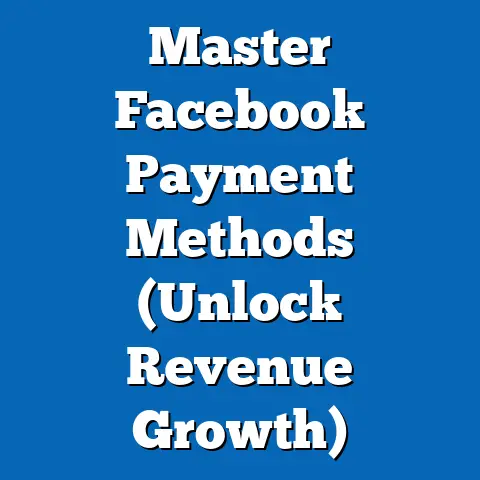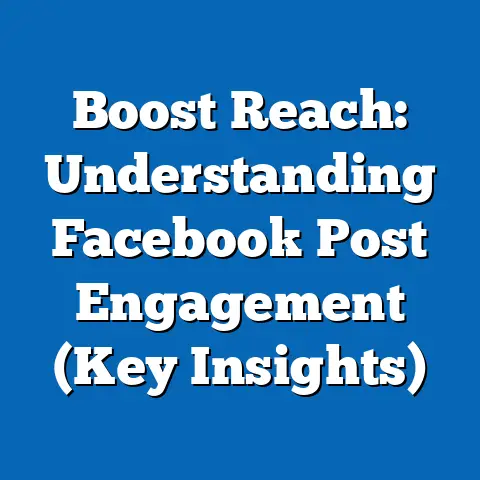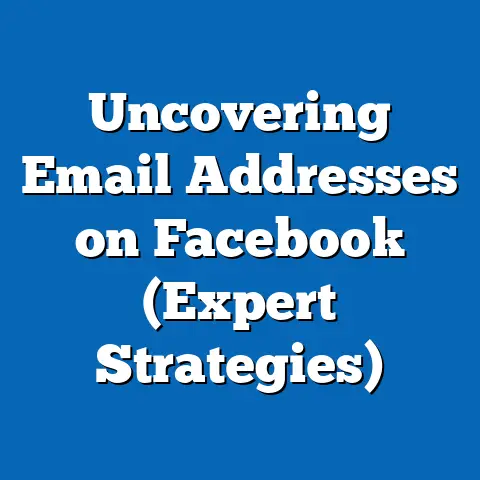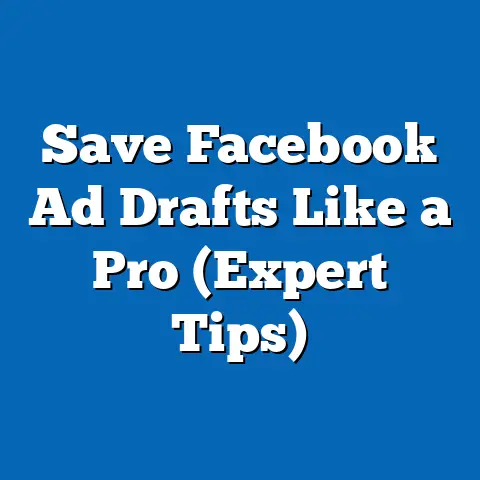Unlock Competitor Facebook Ads Strategy (Insider Tips)
Unlocking Competitor Facebook Ads Strategy: Insider Tips for Success
What if I told you that the secret to skyrocketing your Facebook ad performance lies in dissecting your competitors’ strategies? Sounds intriguing, right? In today’s cutthroat digital landscape, simply creating great ads isn’t enough. You need to understand what your competitors are doing, what’s working for them, and, just as importantly, what isn’t.
I’ve been running Facebook ad campaigns for over a decade, and I can tell you firsthand, ignoring your competition is a recipe for leaving money on the table. Facebook remains a powerhouse in social media advertising. In fact, as of late 2023, Facebook boasts nearly 3 billion monthly active users. This massive reach makes it indispensable for businesses of all sizes. But with so many businesses vying for attention, how do you stand out?
The answer: smart competitor analysis. By leveraging competitor insights, you can optimize your advertising efforts, refine your targeting, and ultimately achieve better results. Think of it as having a peek at their playbook – ethically, of course! This isn’t about copying; it’s about learning, adapting, and innovating.
Let’s get into the nitty-gritty of how to unlock your competitors’ Facebook ad strategies and turn those insights into your own advertising success.
1. Understanding the Competitive Landscape
Before you can analyze your competitors’ ads, you need to know who they are. Sounds simple, but it can be trickier than you think.
Defining Your Facebook Ad Competitors
A competitor in the Facebook ads space isn’t just any business that sells a similar product or service. It’s any business that is actively targeting the same audience as you on Facebook. They’re vying for the same eyeballs, clicks, and conversions. This means you need to consider both direct and indirect competitors.
- Direct Competitors: These are the businesses that offer the same products or services as you and target the same audience. Think of Coke vs. Pepsi.
- Indirect Competitors: These offer different products or services but still compete for the same customer needs or budget. For example, a local gym might consider a weight loss app an indirect competitor.
Tools and Methods for Identifying Competitors
Okay, so how do you find these competitors lurking in the Facebook ad ecosystem? Here are a few methods I’ve found effective:
- Manual Search: Start by searching for your product or service on Facebook. See which businesses are running ads. This is a simple but surprisingly effective method.
- Facebook’s “Why Am I Seeing This Ad?” Feature: When you see an ad that catches your eye, click the three dots in the upper right corner and select “Why am I seeing this ad?” This will give you insights into the targeting criteria used by the advertiser. If they’re targeting similar interests or demographics as you, they’re a competitor.
- Audience Overlap Analysis: Facebook’s Audience Insights tool (now part of Meta Business Suite) can help you identify pages that your audience also likes. This can reveal potential competitors you might not have considered.
- Competitor Analysis Tools: There are several third-party tools designed specifically for competitor analysis in Facebook ads. Examples include:
- SEMrush: While known for SEO, SEMrush also offers robust advertising analysis features, allowing you to see competitor ad spend, keywords, and ad copy.
- SpyFu: SpyFu specializes in competitor keyword research and advertising analysis.
- AdEspresso: AdEspresso provides insights into competitor ad campaigns, including ad spend and performance metrics.
- iSpionage: iSpionage focuses on competitor analysis in search and social advertising.
- SEMrush: While known for SEO, SEMrush also offers robust advertising analysis features, allowing you to see competitor ad spend, keywords, and ad copy.
- SpyFu: SpyFu specializes in competitor keyword research and advertising analysis.
- AdEspresso: AdEspresso provides insights into competitor ad campaigns, including ad spend and performance metrics.
- iSpionage: iSpionage focuses on competitor analysis in search and social advertising.
I personally use SEMrush and AdEspresso. They can be a bit pricey, but the insights they provide are invaluable. I once used SEMrush to discover a competitor was spending a fortune on a keyword I hadn’t even considered. After testing it myself, it became one of my top-performing keywords!
The Importance of Knowing Both Direct and Indirect Competitors
Why bother with indirect competitors? Because they can offer valuable insights into alternative marketing strategies and audience targeting approaches. They might be reaching your target audience in a way you haven’t considered, and learning from their successes (and failures) can give you a significant edge.
Takeaway: Identifying your competitors, both direct and indirect, is the first crucial step in understanding the competitive landscape. Use a combination of manual searches, Facebook’s built-in features, and third-party tools to build a comprehensive list.
2. Analyzing Competitor Ads
Now that you know who your competitors are, it’s time to dive into their ads. Luckily, Facebook makes this relatively easy with its Ad Library.
Using Facebook’s Ad Library
The Facebook Ad Library is a treasure trove of information. It’s a publicly accessible database that contains all active ads running on Facebook and Instagram. Here’s how to use it:
- Go to the Facebook Ad Library: Simply search “Facebook Ad Library” on Google or go directly to https://www.facebook.com/ads/library.
- Select Your Country: Choose the country relevant to your target audience.
- Search for a Competitor: Type in the name of your competitor’s Facebook page.
- Browse Their Ads: You’ll see a list of all active ads running by that page.
A Step-by-Step Guide to Analyzing Competitor Ads
Okay, you’ve got a list of your competitor’s ads. Now what? Here’s a breakdown of how to analyze them effectively:
- Ad Creative (Images/Videos):
- Quality: Are the visuals high-quality and professional?
- Style: What’s the overall aesthetic? Does it align with their brand?
- Content: What’s the ad actually showing? Product demos, customer testimonials, behind-the-scenes footage?
- Effectiveness: Does the visual immediately grab your attention? Does it clearly communicate the ad’s message?
- Ad Copy:
- Headline: Is it attention-grabbing? Does it clearly state the offer or benefit?
- Body Text: Is it concise and persuasive? Does it highlight key features or benefits?
- Call to Action (CTA): Is the CTA clear and compelling? Does it tell the user exactly what to do?
- Tone: Is the tone formal, informal, humorous, or serious? Does it match their brand and target audience?
- Targeting Strategies:
- Location: Are they targeting specific geographic locations?
- Demographics: What age range, gender, and education level are they targeting?
- Interests: What interests are they targeting? This is often the most revealing aspect of their targeting strategy.
- Behaviors: Are they targeting specific behaviors, like purchasing habits or device usage?
- Ad Formats:
- Image Ads: Simple and effective for showcasing products or services.
- Video Ads: Great for storytelling and product demos.
- Carousel Ads: Allow you to showcase multiple products or features in a single ad.
- Collection Ads: Designed for e-commerce businesses, allowing users to browse and purchase products directly from the ad.
- Lead Ads: Collect leads directly from Facebook without sending users to a landing page.
- Quality: Are the visuals high-quality and professional?
- Style: What’s the overall aesthetic? Does it align with their brand?
- Content: What’s the ad actually showing? Product demos, customer testimonials, behind-the-scenes footage?
- Effectiveness: Does the visual immediately grab your attention? Does it clearly communicate the ad’s message?
- Headline: Is it attention-grabbing? Does it clearly state the offer or benefit?
- Body Text: Is it concise and persuasive? Does it highlight key features or benefits?
- Call to Action (CTA): Is the CTA clear and compelling? Does it tell the user exactly what to do?
- Tone: Is the tone formal, informal, humorous, or serious? Does it match their brand and target audience?
- Location: Are they targeting specific geographic locations?
- Demographics: What age range, gender, and education level are they targeting?
- Interests: What interests are they targeting? This is often the most revealing aspect of their targeting strategy.
- Behaviors: Are they targeting specific behaviors, like purchasing habits or device usage?
- Image Ads: Simple and effective for showcasing products or services.
- Video Ads: Great for storytelling and product demos.
- Carousel Ads: Allow you to showcase multiple products or features in a single ad.
- Collection Ads: Designed for e-commerce businesses, allowing users to browse and purchase products directly from the ad.
- Lead Ads: Collect leads directly from Facebook without sending users to a landing page.
Identifying Trends and Spotting Underperforming Ads
As you analyze your competitors’ ads, look for trends. Are they consistently using a particular ad format? Are they focusing on a specific benefit or feature? Are they targeting a particular demographic?
Also, pay attention to ads that seem to be underperforming. If an ad has been running for a long time but has very little engagement, it’s likely not working well. This can be just as valuable as identifying successful ads, as it tells you what not to do.
Takeaway: The Facebook Ad Library is your best friend. Use it to systematically analyze your competitors’ ads, paying close attention to their creative, copy, targeting, and formats. Look for trends and identify underperforming ads to learn from their mistakes.
3. Key Metrics to Monitor
Analyzing the content of your competitor’s ads is important, but understanding the performance of those ads is even more critical. While you can’t see exact performance metrics like cost per click (CPC) or conversion rate, you can estimate the effectiveness of their ads by monitoring certain key metrics.
Essential Metrics to Evaluate
Here are some essential metrics I use to evaluate the effectiveness of competitor ads:
- Engagement Rate: This is the percentage of people who saw the ad and interacted with it (likes, comments, shares, clicks). A high engagement rate suggests the ad is resonating with the target audience.
- Click-Through Rate (CTR): This is the percentage of people who saw the ad and clicked on the link. A high CTR indicates the ad copy and creative are compelling.
- Conversion Rate: While you can’t directly see this, you can infer it based on the ad’s call to action and the landing page it directs to. If the ad is promoting a specific offer or product, and the landing page is well-optimized, it’s likely converting well.
- Ad Duration: How long has the ad been running? If an ad has been running for a long time, it’s a good sign it’s performing well. Facebook’s algorithm favors ads that are engaging and converting.
Estimating Budget and Reach
Estimating a competitor’s budget and reach is more art than science, but it’s possible to get a rough idea based on the observed metrics.
- Engagement: A high engagement rate, particularly on video ads, suggests a significant reach. Facebook rewards engaging ads with lower costs and wider distribution.
- Ad Duration: Ads that run for extended periods generally have a larger budget.
- Ad Variations: If a competitor is running multiple variations of the same ad, they’re likely investing heavily in testing and optimization, indicating a substantial budget.
Keep in mind that Facebook ad costs can vary widely depending on the target audience, industry, and time of year. However, by monitoring these metrics, you can get a sense of whether a competitor is investing heavily in Facebook advertising and whether their efforts are paying off.
Implications for Your Ad Strategy
The metrics you monitor have direct implications for your own ad strategy.
- High Engagement Rate: If a competitor’s ad has a high engagement rate, analyze what’s working well. Is it the creative, the copy, or the targeting? Try to incorporate similar elements into your own ads.
- Long Ad Duration: If an ad has been running for a long time, it’s likely converting well. Analyze the ad closely to understand why it’s successful.
- Low Engagement Rate: If an ad has a low engagement rate, avoid replicating its strategy.
Takeaway: Monitoring key metrics like engagement rate, CTR, and ad duration can give you valuable insights into the effectiveness of your competitors’ ads. Use this information to inform your own ad strategy and avoid making costly mistakes.
4. Identifying Unique Selling Propositions (USPs)
Every successful business has a unique selling proposition (USP) – something that sets them apart from the competition. Identifying your competitors’ USPs is crucial for differentiating your own brand and developing compelling ad copy.
Extracting Competitors’ USPs
How do you extract a competitor’s USP from their ads? Look for the following:
- Key Benefits: What are the main benefits they’re highlighting in their ad copy? Are they focusing on price, quality, convenience, or something else?
- Differentiation: What makes their product or service different from the competition? Are they offering a unique feature, a superior warranty, or a more personalized experience?
- Emotional Appeal: What emotions are they trying to evoke in their ads? Are they appealing to fear, desire, or nostalgia?
The Importance of USPs
A strong USP is essential for cutting through the noise and grabbing the attention of your target audience. It tells them why they should choose you over the competition. Without a clear USP, your ads will likely get lost in the shuffle.
Examples of Effective USPs
Here are a few examples of effective USPs from well-known brands:
- Domino’s Pizza: “You get fresh, hot pizza delivered to your door in 30 minutes or less—or it’s free.” This USP focuses on speed and guarantee.
- M&M’s: “The milk chocolate melts in your mouth, not in your hand.” This USP highlights a unique feature and addresses a common concern.
- Volvo: “For life.” This USP emphasizes safety and reliability.
Developing Compelling Ad Copy
Once you’ve identified your competitors’ USPs, you can use this information to develop compelling ad copy that highlights your own unique advantages. Don’t just copy their USP; instead, focus on what makes you different and better.
Takeaway: Identifying your competitors’ USPs is essential for differentiating your brand and developing compelling ad copy. Focus on what makes you unique and better than the competition.
5. Leveraging Audience Insights
Understanding your target audience is crucial for any successful Facebook ad campaign. Analyzing your competitors’ ads can provide valuable insights into their target audience demographics and interests.
Gathering Insights on Target Audience
How do you gather insights on target audience demographics and interests from competitor ads?
- Ad Targeting: As mentioned earlier, Facebook’s “Why am I seeing this ad?” feature can reveal valuable information about the targeting criteria used by your competitors.
- Ad Engagement: Pay attention to the demographics of people who are engaging with your competitors’ ads. Are they primarily men or women? What age range are they in? What interests do they have?
- Page Likes: Look at the other pages that people who like your competitors’ pages also like. This can reveal additional interests and potential targeting opportunities.
Refining Your Audience Targeting
Once you’ve gathered these insights, you can use them to refine your own audience targeting.
- Expand Your Reach: If you discover that your competitors are targeting interests you haven’t considered, add them to your targeting criteria.
- Narrow Your Focus: If you discover that your competitors are targeting a broad audience, try narrowing your focus to a more specific segment.
- Create Custom Audiences: Use the insights you’ve gathered to create custom audiences based on specific demographics, interests, or behaviors.
A/B Testing Audience Segments
The best way to determine which audience segments are most responsive to your ads is to A/B test different segments. Create multiple ad sets, each targeting a different audience segment, and track the performance of each ad set. This will help you identify your optimal target market.
I remember one campaign where I assumed my target audience was primarily women aged 25-34. However, after analyzing my competitors’ ads and conducting A/B testing, I discovered that men aged 35-44 were actually more responsive to my ads. This completely changed my targeting strategy and significantly improved my results.
Takeaway: Analyzing your competitors’ ads can provide valuable insights into their target audience demographics and interests. Use this information to refine your own audience targeting and A/B test different audience segments to find your optimal target market.
6. Ad Copy and Creative Strategies
The ad copy and creative are the heart and soul of any Facebook ad. Analyzing your competitors’ ad copy and creative strategies can provide valuable inspiration and help you avoid making costly mistakes.
Analyzing Language, Tone, and Style
Pay close attention to the language, tone, and style used in your competitors’ ad copy.
- Language: Is the language formal or informal? Are they using jargon or plain English?
- Tone: Is the tone humorous, serious, or inspirational?
- Style: Is the writing concise and to the point, or more descriptive and narrative?
The language, tone, and style you use should align with your brand and target audience. If your competitors are using a particular style that seems to be working well, consider adapting it to your own brand.
Evaluating Visual Effectiveness
The visuals you use in your ads are just as important as the ad copy. Evaluate the effectiveness of your competitors’ visuals.
- Quality: Are the images or videos high-quality and professional?
- Relevance: Are the visuals relevant to the product or service being advertised?
- Attention-Grabbing: Do the visuals immediately grab your attention?
- Emotional Appeal: Do the visuals evoke an emotional response?
If your competitors are using visuals that seem to be resonating with the target audience, analyze what’s working well and try to incorporate similar elements into your own ads.
Adapting Successful Elements
Don’t be afraid to adapt successful elements from your competitors’ ads into your own advertising strategy. This doesn’t mean copying their ads verbatim; instead, focus on understanding why they’re successful and adapting those elements to your own brand and messaging.
Remember, authenticity is key. Your ads should reflect your brand’s unique personality and values.
Takeaway: Analyze your competitors’ ad copy and creative strategies to gain inspiration and avoid making costly mistakes. Adapt successful elements to your own brand while maintaining authenticity.
7. Staying Ahead of the Curve
The world of Facebook advertising is constantly evolving. New features, targeting options, and ad formats are being introduced all the time. To stay ahead of the curve, you need to continuously monitor your competitors’ strategies and adapt your own accordingly.
Keeping Up with Competitor Changes
How do you keep up with competitor changes and updates in their ad strategies?
- Regular Monitoring: Set aside time each week to review your competitors’ ads in the Facebook Ad Library.
- Alerts: Use tools like Google Alerts to track mentions of your competitors online.
- Social Listening: Monitor social media channels for mentions of your competitors and their products or services.
Continuous Learning and Adaptation
Continuous learning and adaptation are essential for success in Facebook advertising. Stay up-to-date on the latest industry trends and best practices.
- Read Industry Blogs: Subscribe to industry blogs and newsletters to stay informed about the latest trends and best practices.
- Attend Webinars and Conferences: Attend webinars and conferences to learn from industry experts.
- Experiment: Don’t be afraid to experiment with new features, targeting options, and ad formats.
The Role of Industry Trends and Consumer Behavior
Industry trends and consumer behavior shifts can have a significant impact on your ad strategies. Pay attention to these trends and adapt your ads accordingly.
For example, if there’s a growing trend toward sustainability, highlight the eco-friendly aspects of your products or services. If consumers are increasingly using mobile devices, optimize your ads for mobile viewing.
Takeaway: Staying ahead of the curve requires continuous monitoring, learning, and adaptation. Pay attention to industry trends and consumer behavior shifts, and adapt your ads accordingly.
Conclusion
Congratulations! You’ve now got a comprehensive understanding of how to unlock your competitors’ Facebook ad strategies and turn those insights into your own advertising success.
Competitor analysis is not a one-time task; it’s an ongoing process. You need to continuously monitor your competitors’ ads, analyze their performance, and adapt your own strategies accordingly. Think of it as a dynamic tool for refining your Facebook ad strategies.
By implementing these insider tips, you can enhance your advertising success, build a more competitive edge in your respective markets, and ultimately achieve your business goals.
Call to Action
Now it’s your turn! Share your experiences with competitor analysis in Facebook ads and any additional tips you may have in the comments section below. And don’t forget to subscribe for more insights and updates on digital marketing strategies!





